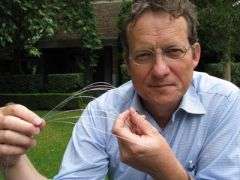Scientists use bubbles to future-proof fibre optics

(PhysOrg.com) -- They're tiny, are rarely thought about by the people who use them, but are essential to how we access information, communicate with one another and live our everyday lives.
Optical fibres make it possible for us to use the technologies we take for granted such as the Internet and our mobile phones, and now new research from Macquarie University may hold the key to more cost-effective, energy-efficient, durable and easy-to-use fibre optics in the future.
A team of fibre optics specialists from the University's Department of Electronic Engineering has been developing a new prototype for fibre optics which is made from a "bubbly" polymer fibre.
Traditionally, glass has been used to produce optical fibres, but the equipment needed in order to process the glass at high temperatures makes this an expensive option.
While several groups around the world are investigating polymer as a potential future replacement, the Macquarie team is the only group to develop and test a system which uses bubbles within the polymer to guide and scatter light.
Head of Electronic Engineering Professor Graham Town said most researchers investigating microstructured polymer fibres were using stacked tubes or small holes drilled in a polymer preform, subsequently drawn down to micron-sized dimensions to guide light.
"Our technique involves heating the polymer to form bubbles - it's easier and cheaper than assembling tubes or drilling," Town said.
"This could be a cheap, clean and relatively fast way of developing an optical network - and the production process uses significantly less energy than if we were working with glass."
Deliberately leaky fibres are ideal for transmitting data over short distances. Another advantage of the bubbly polymer is that it allows light out and in, which makes it potentially very useful for sensing applications.
"This type of polymer optical fibre may prove useful for distributed sensing of materials such as toxic or explosive gases," Town said.
Provided by Macquarie University





















